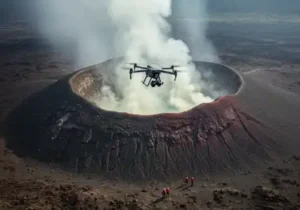For decades, scientists have sought reliable early warning signs of volcanic eruptions. While seismic activity and ground deformation are often the focus, new research shows that high-frequency gas monitoring—particularly tracking carbon dioxide (CO₂) emissions—can reveal clear precursors to volcanic activity. This breakthrough offers a promising addition to eruption forecasting and hazard mitigation.
Why CO₂ Matters in Volcanic Monitoring
 Carbon dioxide is one of the first gases released from magma as it rises toward the surface. Unlike sulfur dioxide (SO₂), which is often emitted later and in more visible plumes, CO₂ escapes earlier because it is less soluble in magma under pressure. Detecting a sudden increase in CO₂ emissions can therefore provide advance notice of potential unrest inside a volcano.
Carbon dioxide is one of the first gases released from magma as it rises toward the surface. Unlike sulfur dioxide (SO₂), which is often emitted later and in more visible plumes, CO₂ escapes earlier because it is less soluble in magma under pressure. Detecting a sudden increase in CO₂ emissions can therefore provide advance notice of potential unrest inside a volcano.
Volcano observatories have traditionally monitored gas output at intervals of days or weeks. However, high-frequency monitoring—recording data in near-real time—offers a far more detailed picture of gas fluctuations, helping identify subtle but significant patterns.
Breakthrough at Turrialba Volcano
One of the most compelling case studies comes from Turrialba Volcano in Costa Rica. Researchers installed advanced sensors capable of measuring CO₂ and SO₂ emissions multiple times per minute. Over several months, they observed that CO₂ levels spiked days before notable eruptive activity, while SO₂ emissions increased much closer to the actual eruption time.
This consistent sequence—CO₂ spike followed by SO₂ rise—suggests a clear magmatic signal. It indicates that magma is ascending and releasing CO₂ long before surface activity is visible, allowing scientists to extend the warning window for communities living nearby.
Gas monitoring equipment detecting early CO₂ spikes at Turrialba Volcano.
How High-Frequency Gas Monitoring Works
Modern volcanic gas monitoring uses a combination of:
- Multi-GAS analyzers: Portable instruments measuring CO₂, SO₂, and H₂S concentrations.
- FTIR spectroscopy: Detects gas compositions remotely by analyzing infrared absorption.
- Continuous station networks: Permanently installed sensors that transmit real-time data to observatories.
Data are then analyzed for CO₂/SO₂ ratios. A sudden jump in CO₂ without a corresponding SO₂ increase can indicate deep magma degassing before it approaches the surface.
Why This Is a Game-Changer for Eruption Forecasting
Integrating high-frequency gas data with seismic and deformation monitoring creates a more robust early warning system. CO₂ tracking can help:
- Increase lead time for evacuation planning.
- Reduce false alarms by correlating gas signals with other activity indicators.
- Understand magma dynamics by mapping gas release stages.
This approach is particularly valuable for volcanoes that produce small or infrequent earthquakes, where seismic data alone may be insufficient for timely warnings.
Implications for the Deep Carbon Cycle
Beyond hazard prediction, high-frequency CO₂ monitoring also enriches our understanding of the deep carbon cycle. Volcanic emissions are a primary pathway for carbon stored deep within Earth to reach the atmosphere. By quantifying CO₂ output before, during, and after eruptions, scientists can better estimate the contribution of volcanic degassing to the global carbon budget.
These measurements link directly to research on deep Earth carbon degassing and volcanoes as nature’s carbon release valves.
Challenges and Limitations
While promising, high-frequency CO₂ monitoring faces challenges:
- Harsh conditions: Sensors must withstand extreme heat, corrosive gases, and difficult terrain.
- Maintenance demands: Continuous data collection requires regular calibration and servicing.
- Data interpretation: Not all CO₂ spikes lead to eruptions, and background emissions vary by volcano.
Nevertheless, the technology is advancing rapidly, with improvements in sensor durability, wireless data transmission, and AI-based data analysis.
Looking Ahead
 As more volcano observatories adopt high-frequency gas monitoring, early detection of eruption precursors will likely become standard practice. Integration with satellite monitoring and drone-based gas measurements could further improve spatial coverage and reduce risk to scientists in the field.
As more volcano observatories adopt high-frequency gas monitoring, early detection of eruption precursors will likely become standard practice. Integration with satellite monitoring and drone-based gas measurements could further improve spatial coverage and reduce risk to scientists in the field.
Ultimately, the combination of ground-based sensors, remote sensing, and geochemical modeling offers a powerful toolkit for protecting lives and enhancing our understanding of Earth’s dynamic systems.
Key Takeaways
- CO₂ spikes often precede volcanic eruptions by days, providing valuable warning time.
- High-frequency monitoring reveals gas trends invisible in low-frequency measurements.
- Integrating gas data with seismic and deformation monitoring improves eruption forecasts.
- Findings contribute to both public safety and deep carbon cycle research.



